How to Reduce Our "Hidden Self" and Our "Blind Self"
Suzuko Nishihara Executive Director, The Japan Foundation Japanese-Language Institute, Urawa
"Japanese-language education overseas", "arts and cultural exchange", and "Japanese studies and intellectual exchange" make up the three fields in which the Japan Foundation conducts international cultural exchange projects.
Projects for "Japanese-language education overseas" are implemented through the Japanese language, aiming on the one hand to draw attention to aspects of Japan that we hope will attract people's interest and understanding, and, on the other, to make available a variety of material from Japan for people to use and enjoy. I would like to suggest a metaphor that we can use to consider this matter from a slightly different perspective.
"Hidden Self" and "Blind Self"
There is a classic theory in communication psychology research known as "the Johari window". Proposed by Joseph Luft and Harry Ingham, it is a graphic model of interpersonal awareness, which offers suggestions for communication process, taking the ways to reveal and conceal ourselves as a key. It came to be known as "the Johari window," combining the names of the two authors. The model is shown in the figure below.
The four windows in the following figure are not fixed in size. Expansion of the "open self" means progress in self-disclosure and mutual understanding; a decrease in the "unknown self" generates new discoveries both for oneself and others. What I would like to concentrate on here are the "hidden self" and the "blind self."
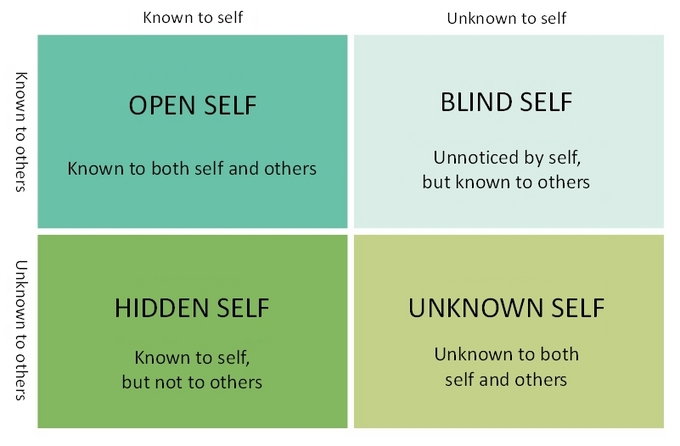 The "Johari window," a graphic model of interpersonal awareness
The "Johari window," a graphic model of interpersonal awareness
Let's consider how this would look if we substitute "Japan" for "self," and "other countries" for "others."
As the "open Japan" window gets larger, mutual understanding between Japan and other countries deepens; similarly, as information disseminated from Japan leads to increased understanding of Japan abroad, the "hidden Japan" shrinks.
At the same time, comments and criticism from abroad can clarify what had previously gone unrecognized in Japan; thus they lead to reduce the area of the "blind Japan." In other words, this provides an opportunity for self-analysis, enabling us to see aspects that need reform. Japanese-language learning is the first step to spark this process.
As the "hidden Japan" and the "blind Japan" become relatively smaller, the "open Japan" becomes larger, leading to the development of a win-win relationship between Japan and overseas countries. This is the direction pursued by the Japan Foundation's Japanese-language education.
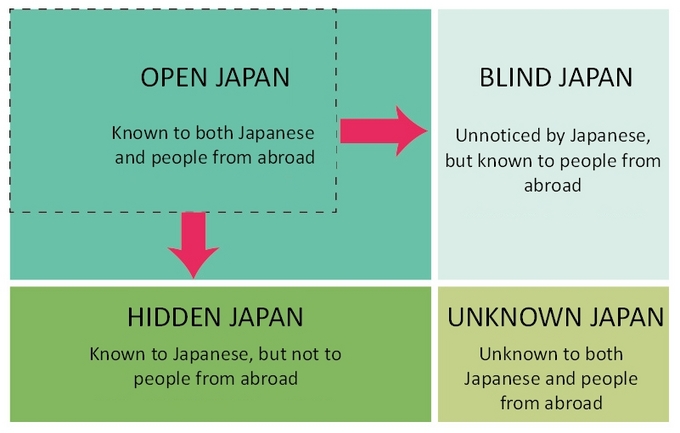 Japanese-language learning expands the "open Japan" and reduces the "hidden Japan" and "blind Japan".
Japanese-language learning expands the "open Japan" and reduces the "hidden Japan" and "blind Japan".
"JF Standard"--a tool for expanding the "Open Japan"
I would like to present an example of one specific strategy that the Japan Foundation is pursuing in the area of Japanese-language projects aimed at promoting "self-disclosure" by Japan vis-à-vis countries overseas. Released in 2010, the JF Standard for Japanese-Language Education (hereinafter "JF Standard") is a tool to help us think about teaching, learning, and assessment in Japanese-language education. The JF Standard was developed based on the concepts supporting the CEFR, which serve as the basis of language education in Europe. CEFR stands for Common European Framework of Reference for Languages: Learning, Teaching, Assessment, and presents a framework shared by language education and learning institutions in Europe. By sharing a theoretical framework with language educators around the world, the JF Standard provides proficiency levels that can be readily understood by Japanese students and teachers in classrooms overseas.
In the process of developing the JF Standard, we looked at language communication in terms of the relationship between communicative language competences and communicative language activities, expressed in the image of a tree shown below.
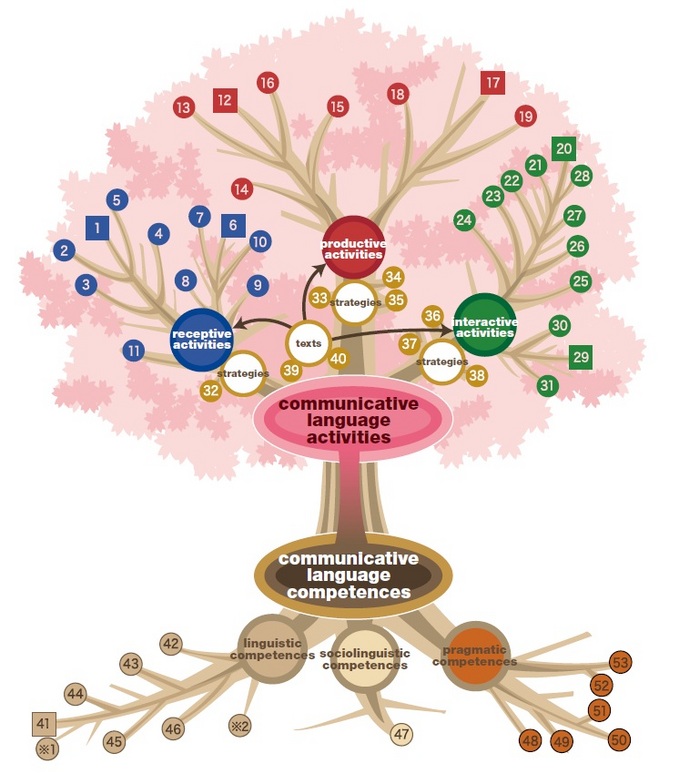 The "JF Standard Tree" depicts the relationship between communicative language activities and communicative language competences in the form of a tree. It can be used to think about what the learner can or wants to do in Japanese, and what communicative language competences (vocabulary, grammar, sociolinguistic skills, and so on) are needed for that purpose.
The "JF Standard Tree" depicts the relationship between communicative language activities and communicative language competences in the form of a tree. It can be used to think about what the learner can or wants to do in Japanese, and what communicative language competences (vocabulary, grammar, sociolinguistic skills, and so on) are needed for that purpose.
Based on this, Japanese proficiency is described in terms not of how much you know about Japanese, but according to benchmarks of what you can do using Japanese, classified in six "Can-do" levels.
The levels from A1 to C2 refer to competences that are common across almost all languages. As a result, students from abroad can respond to recruitment advertisements from Japan or from Japanese companies by indicating their "Can-do" levels on their resume.
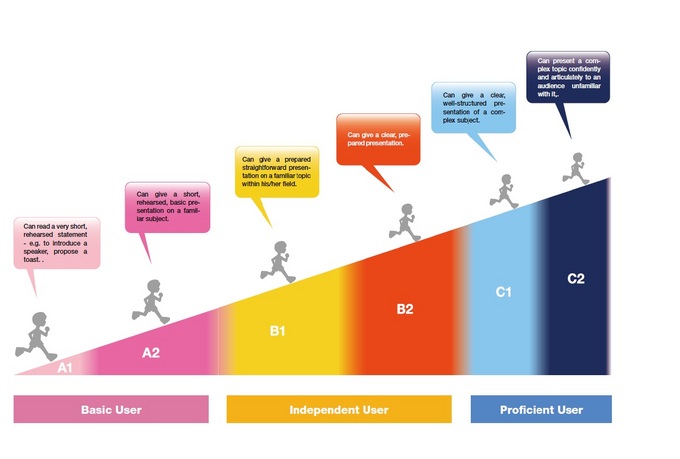 The "Can-do" levels indicate what the learner "can do" in Japanese, according six levels: Basic User (A1, A2), Independent User (B1, B2), and Proficient User (C1, C2). This is useful for thinking about Japanese-language learning in terms of what learners can do with what they have learned, rather than how many words or kanji characters they know.
The "Can-do" levels indicate what the learner "can do" in Japanese, according six levels: Basic User (A1, A2), Independent User (B1, B2), and Proficient User (C1, C2). This is useful for thinking about Japanese-language learning in terms of what learners can do with what they have learned, rather than how many words or kanji characters they know.
Development of "Marugoto: Japanese Language and Culture"
We are currently developing "Marugoto: Japanese Language and Culture", a series of teaching resource based on the JF Standard. The books are soon to be released, and it is expected that they will contribute to increase transparency of curriculum design and proficiency assessment.
Specialists have devoted unceasing efforts to transform the learning experience for Japanese learners worldwide from an adventurous journey in a maze with no exit in sight, to a well-marked and enjoyable hiking course with a clear destination. We hope you will share in our anticipation of the upcoming release of the series.
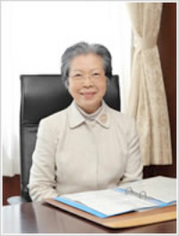 Suzuko Nishihara
After a career in Japanese-language education in the U.S., Indonesia, and Australia, she joined the National Institute for Japanese Language and Linguistics, followed by a teaching post at Tokyo Woman's Christian University (1998-2009). She previously served as chair of The Society for Teaching Japanese as a Foreign Language, and as a member of the Council for Cultural Affairs. She holds a Ph.D. from the University of Michigan, and assumed her current role, Executive Director of the Japan Foundation Japanese-Language Institute, Urawa in April 2012.
Suzuko Nishihara
After a career in Japanese-language education in the U.S., Indonesia, and Australia, she joined the National Institute for Japanese Language and Linguistics, followed by a teaching post at Tokyo Woman's Christian University (1998-2009). She previously served as chair of The Society for Teaching Japanese as a Foreign Language, and as a member of the Council for Cultural Affairs. She holds a Ph.D. from the University of Michigan, and assumed her current role, Executive Director of the Japan Foundation Japanese-Language Institute, Urawa in April 2012.
Related Events
Back Issues
- 2022.11. 1 Inner Diversity<3> <…
- 2022.9. 5 Report on the India-…
- 2022.6.24 The 48th Japan Found…
- 2022.6. 7 Beyond Disasters - …
- 2021.3.10 Crossing Borders, En…
- 2020.7.17 A Millennium of Japa…
- 2020.3.23 A Historian Interpre…
- 2019.11.19 Dialogue Driven by S…
- 2019.10. 2 The mediators who bu…
- 2019.6.28 A Look Back at J…

